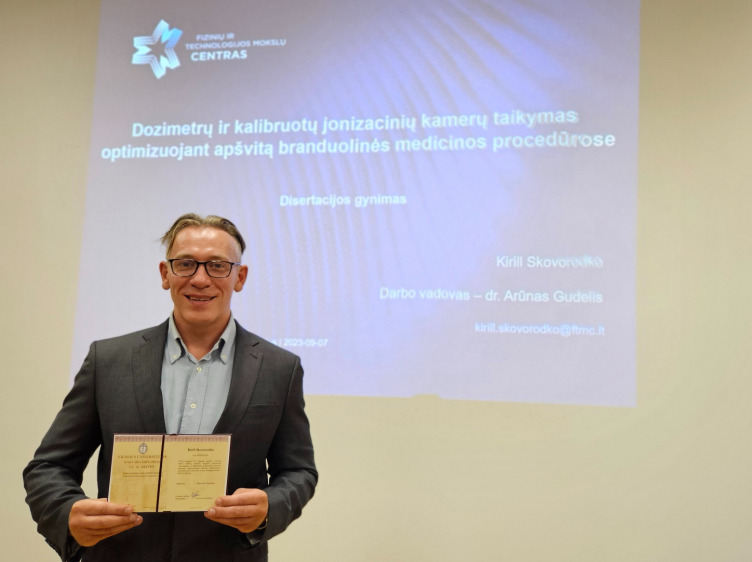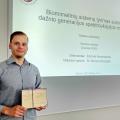- Home
- Nekoreguojami
- Search
Search
2023. 09. 07
-
Medical physicist K. Skovorodko defends his PhD thesis on ionizing radiation research
Kirill Skovorodko, a scientist of the Department of Nuclear Research at FTMC, has defendend his PhD. He also works at Vilnius University Hospital Santaros Klinikos and is the President of the Lithuanian Medical Physicists Society.
Kirill defended his thesis entitled "Application of Dosimeters and Calibrated Ionization Chambers in Optimization of Exposure in Nuclear Medicine Procedures" (academic supervisor – Dr. Arūnas Gudelis).
Congratulations to our colleague and best wishes for continued meaningful work!
In recent years, the demand for nuclear medicine has been growing rapidly. It is an increasingly popular field that brings together different learning disciplines and branches of science, such as physics, biology, mathematics, information technology, chemistry, medicine and others.
Nuclear medicine is characterised by the use of various radiopharmaceuticals (drugs that may contain radioactive isotopes when prepared for use) for the detection, treatment, monitoring of disease response and biomedical research.
"The main nuclear medicine equipment we use is a activity meter, which measures the amount of radioactive material (activity) injected into a patient. The patient is then put to bed and the body is monitored using special scanners. The most commonly used scanners are single photon emission computed tomography (SPECT) scanners, combined with computerized tomography (CT) scans. Positron emission tomography (PET) devices are also rapidly gaining popularity", says Skovorodko.
This technique is mainly used to investigate and treat oncological diseases.

(Defending a PhD. Photo: FTMC)
The World Nuclear Association estimates that the amount of nuclear medicine equipment and the number of examinations carried out grows by 5% each year.
According to FTMC scientist, this is an area that is rapidly advancing technologically: "For example, one of the latest procedures we are currently carrying out is the treatment of the liver with radioactive holmium (Ho-166), which is placed in microspheres, and then the compound is injected into the liver. Specialists from many different fields are working on this one procedure."
As medical staff work with equipment and radiopharmaceutical compounds (open sources of ionizing radiation), it is crucial to find out how to ensure radiation safety - for both patients and staff. A lot of attention must be paid to accuracy: if the patient receives too little exposure, the equipment will not have enough information to give the doctor a proper picture of the body's condition. And if the exposure is too high, there is an additional risk to the health of both patients and medical staff. The latter could theoretically be a particularly vulnerable group, as they are working with ionizing radiation all the time.
Also, as nuclear medicine equipment is complex, it is necessary to check and measure its quality.
These are precisely the issues that Kirill addressed in his work. He has studied the principles and methods of radiation protection in nuclear medicine, as well as metrology methods and other parameters and factors that affect the accuracy of the equipment and the exposure of patients and medical staff to ionizing radiation.
He has written 6 publications (half of which he was lead author) in international scientific journals.

(Dr. Kirill Skovorodko with his colleagues from the Department of Nuclear Research. Photo: FTMC)
"Our research is novel in Lithuania and the Baltic region in that all activity meters used in nuclear medicine departments in Lithuania for clinical purposes have been tested and their bias evaluated. Once this was done, it was time to move on to other work. One of the most significant was to assess the diagnostic reference levels awareness. These are the parameters for how much radioactive material we inject and use in nuclear medicine. If these levels are too high or too low, practitioners will immediately question whether these are optimized doses. So this is a tool to make a more targeted assessment of what doses are given to patients.
These diagnostic reference levels are not adopted by all EU countries, and in Lithuania, these levels have been developed and updated following an assessment of clinical practice and current data. They will be available for use and reference by other countries. In addition, we have also taken into account the emergence of new equipment in the practice of nuclear medicine," says the new PhD.
One of the conclusions of the thesis is that it answers the question of whether nuclear medicine workers in Lithuania are exposed to excessive doses of radiation: "We can say that the risk that we have studied (of developing thyroid cancer or leukaemia) is very low. The predicted risk of a factor attributable to exposure to ionizing radiation (per 100 000 people) is up to ~10-5. We have a good trend that those doses are decreasing. We have assessed that nuclear medicine is a really safe field in this respect."
FTMC information
Related news:
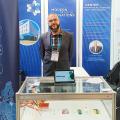
2023. 09. 20
-
FTMC researchers presenting artificial organ support at prestigious life sciences event
K. Kižys and his team are presenting a biocell technology under development that could revolutionize waste recycling and have applications in medicine.
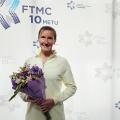
2023. 09. 15
-
Physicist interested in black silicon L. Golubewa becomes the new PhD in Natural Sciences
Desired technology sounds like something out of science fiction - but science is moving towards it, and Lena is contributing to it too.
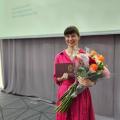
2023. 09. 08
-
S. Pūkienė, a physicist who develops sensors, becomes a PhD in Technological Sciences
How can gallium arsenide bismide serve science and society?
